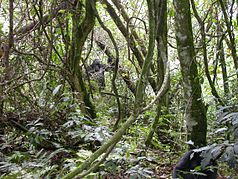Bwindi Impenetrable National Park
| Bwindi Impenetrable National Park | ||
|---|---|---|
| Mountain gorillas in Bwindi | ||
|
|
||
| Location: | Uganda | |
| Surface: | 331 km² | |
| Founding: | 1991 | |
| Boundaries of the national park | ||
The Bwindi Rainforest is a national park in southwest Uganda . It extends over the flanks of the Albert Rift , the northernmost part of the East African Rift Valley . The tropical rainforest of the Bwindi is original and very old. It has developed into what it represents today since the last Ice Age . The height of the park above sea level ranges from 1160 m to 2607 m. The park is on the 1994 UNESCO list of World Heritage .
prehistory
In the area of today's national park, ecological protection zones were established as early as 1932, when the British colonial government at the time created forest reserves that extended over an area of 20,700 hectares in the northern and southern parts of the present area.
In 1942 these areas were then merged and expanded to an area of 298 square kilometers. The area reached its current extent through the addition of two additional forest areas. At that time, today's national park was known as the Impenetrable Central Forest Reserve and was given national park status in 1991.
fauna
With 400 animals, around half of all mountain gorillas still alive today, according to the last census in 2012, can be found in the protected area of the Bwindi Forest . The endangered species is also protected in Uganda in the Mgahinga Gorilla National Park in the area of the Virunga volcanoes . Other populations live in the immediate vicinity of the park in Rwanda and the Democratic Republic of the Congo .
A total of around 90 species of mammals live in Bwindi , including ten other species of monkey such as the black and white guereza (a large colobus monkey ) and chimpanzees, as well as elephants and various small antelopes . Among the bird species there are 23 endemic species that are only native to this area.
Web links
- Entry on the UNESCO World Heritage Center website ( English and French ).
- Uganda Wildlife Authority : Bwindi Impenetrable National Park.
- visituganda.com : Bwindi Impenetrable Forest.
- “The mountain gorillas from Bwindi. Research on Primates in Uganda's National Park ” , SWR2 , April 14, 2008, with manuscript, audio file and picture gallery
Individual evidence
- ↑ UNESCO World Heritage Center: Bwindi Impenetrable National Park. Retrieved August 22, 2017 (English).
- ↑ Wilber Manyisa Ahebwa: Tourism, livelihoods and biodiversity conservation: an assessment of tourism related policy interventions at Bwindi Impenetrable National Park (BINP), Uganda, dissertation 2012 http://edepot.wur.nl/210558
- ↑ Netzeitung : "Return of the Silverback" ( Memento of May 21, 2007 in the Internet Archive ), April 20, 2007



